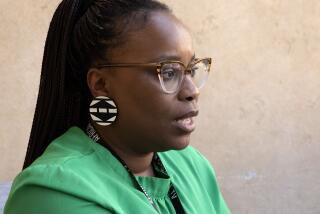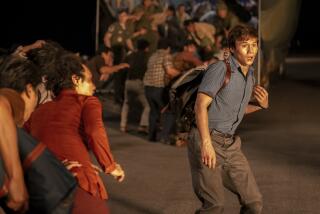Vietnam’s Film Makers Focus on Human Side of War--and Morality of Revolution
- Share via
HO CHI MINH CITY, Vietnam — In the final frames, the beautiful Vietnamese heroine stands triumphant over a downed U.S. helicopter who had killed her husband. As the flames lick at the wreckage, the camera zooms in on a snapshot fallen from the dead pilot’s pocket--of his wife and son.
Hardly subtle, but then again, hardly “Rambo.”
Unlike Hollywood movies that highlight the horror of America’s involvement in Vietnam, Hanoi’s war films focus on the people caught up in it. And, of course, there is no question of the war’s morality--the revolutionary side is assumed to be right.
“We focus on human fate in war, not on the horror,” said Viet Thanh, deputy director of the General Film Co. of Ho Chi Minh City (formerly Saigon). “In this film, the two men die, but (the question is) what will happen to the women on both sides?”
“Platoon,” “Full Metal Jacket,” “Hamburger Hill” and the trailblazing “Apocalypse Now” all had their bloody battles, but there are few large-scale fighting scenes in Vietnam’s war movies. Hanoi’s film makers attribute this partly to low budgets, but they also say their audiences do not want to see the violence.
“We don’t think depicting the horrible parts is necessary,” said Thanh, a southern-born film maker who moved to the Communist north in 1954. “We have lived the war, and we know it for what it is.”
Simple Plot
“The Wide Field,” the 1981 movie that ended with the shooting down of the American helicopter, spends much of its footage on the simple life of a guerrilla, his wife and child on the vast, watery Plain of Reeds in South Vietnam.
The plot is simple: The war, arriving mostly in the form of American helicopters, intrudes on a family life that centers around the simple tasks of catching fish, gathering flowers, finding turtles and growing rice.
The hero is a guide for the revolutionary forces. He takes troops through the swamp to stage attacks on the Americans, who search desperately for the guerrilla route through the delta.
Finally, the helicopters locate and kill the hero, but other guerrillas, including his wife, shoot down one of the helicopters, whose American pilot, played by a Eurasian actor, already has been shown to have a wife and child about the same age as that of the guerrilla.
“We wanted to show that war brings suffering for women and children. We know that on the American side there are also human beings,” Thanh said.
The idea of empathy for the other side is shown even more obviously in another popular film, “Sunflowers in Front of a Grave.”
The movie traces the struggles of an American pilot shot down in the mountains and of a hill tribe woman and her baby caught up in the fighting.
At the end, the bare-breasted woman finds the dying pilot, who begs for water. She has none, but in the final frames the pilot dies peacefully with milk on his grizzled beard and the woman quite literally walks off into the sunset.
Highly Romantic
Vietnamese literary and film tradition is highly romantic, and that has carried over into treatment of the war. The focus of many films is the nature of love in war, not the war itself.
Still, an element of propaganda is rarely absent.
“Our war films show which side is fighting for the legal cause. We try not to be too heavy handed,” Thanh said. “It should appear to the audience that it is up to them to decide which side is right, but the film should make it clear.”
The most popular Vietnamese screen product is the saga of a man who rises in the government of South Vietnam, all the while working as a Communist agent--a true story.
The series, directed by Le Hoang Hoa, who studied film at the University of Southern California, started in 1982 and is now up to eight episodes.
Another film is planned on the real stories of children who helped the revolutionary forces during the war.
More to Read
Only good movies
Get the Indie Focus newsletter, Mark Olsen's weekly guide to the world of cinema.
You may occasionally receive promotional content from the Los Angeles Times.










